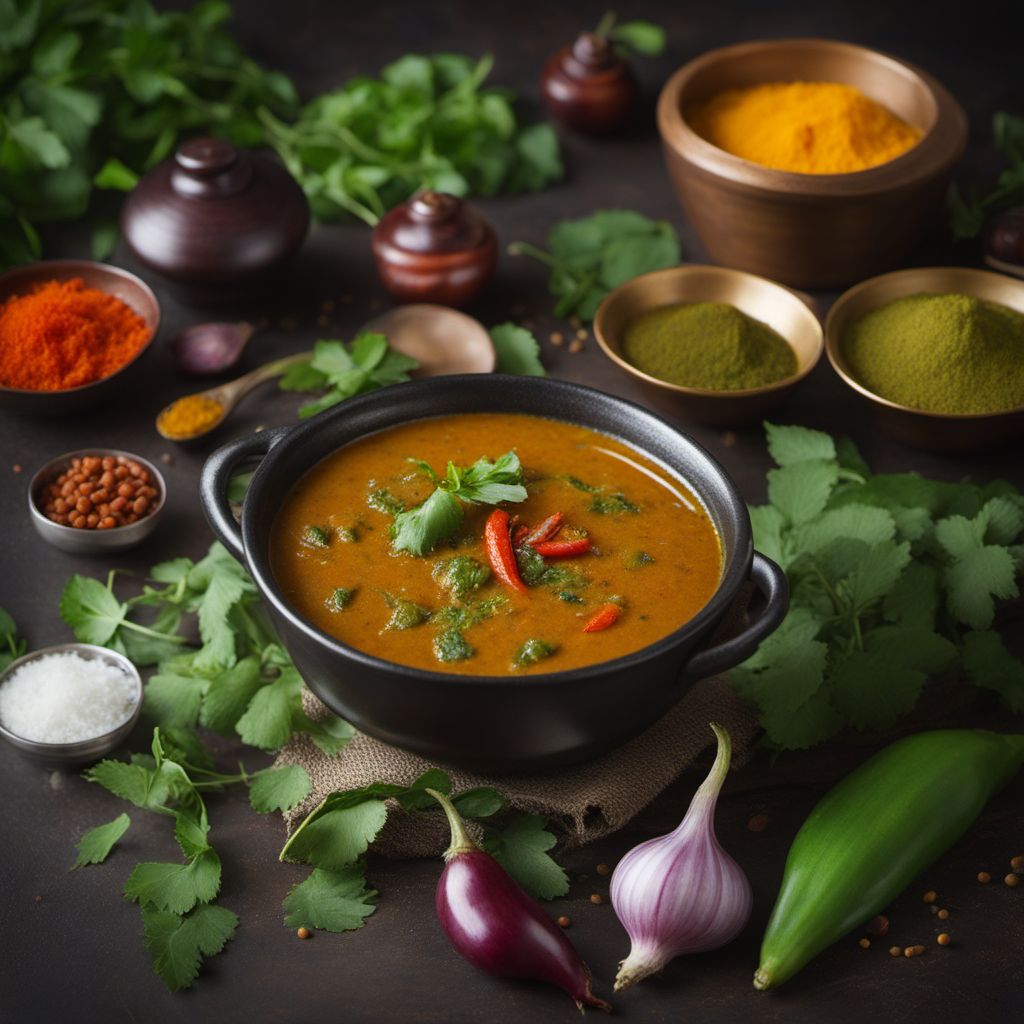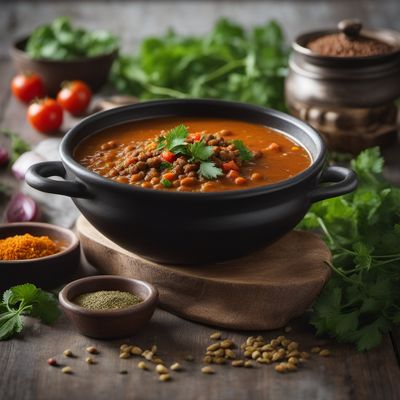
Recipe
Authentic South Indian Sambar
Spicy Lentil Stew: A Burst of Flavors from South India
4.8 out of 5
Indulge in the rich and aromatic flavors of South India with this authentic Sambar recipe. This traditional dish is a staple in Indian cuisine and is known for its unique blend of spices and hearty ingredients.
Metadata
Preparation time
20 minutes
Cooking time
40 minutes
Total time
60 minutes
Yields
4 servings
Preparation difficulty
Medium
Suitable for
Vegetarian, Vegan, Gluten-free, Dairy-free, Nut-free
Allergens
N/A
Not suitable for
Paleo, Keto, Low-carb, High-protein, Atkins
Ingredients
-
1 cup (200g) toor dal (split pigeon peas) 1 cup (200g) toor dal (split pigeon peas)
-
3 cups (710ml) water 3 cups (710ml) water
-
1 small eggplant, diced 1 small eggplant, diced
-
1 medium carrot, diced 1 medium carrot, diced
-
1 medium potato, diced 1 medium potato, diced
-
1 medium tomato, chopped 1 medium tomato, chopped
-
10-12 okra, trimmed and halved 10-12 okra, trimmed and halved
-
1 drumstick, cut into 2-inch pieces 1 drumstick, cut into 2-inch pieces
-
1 small onion, finely chopped 1 small onion, finely chopped
-
2 cloves garlic, minced 2 cloves garlic, minced
-
2 tablespoons sambar powder 2 tablespoons sambar powder
-
1 teaspoon turmeric powder 1 teaspoon turmeric powder
-
1 teaspoon tamarind paste 1 teaspoon tamarind paste
-
1 tablespoon vegetable oil 1 tablespoon vegetable oil
-
1 teaspoon mustard seeds 1 teaspoon mustard seeds
-
1 teaspoon cumin seeds 1 teaspoon cumin seeds
-
1/2 teaspoon fenugreek seeds 1/2 teaspoon fenugreek seeds
-
A few curry leaves A few curry leaves
-
Salt to taste Salt to taste
-
Fresh cilantro, for garnish Fresh cilantro, for garnish
Nutrition
- Calories (kcal / KJ): 250 kcal / 1046 KJ
- Fat (total, saturated): 4g, 0.5g
- Carbohydrates (total, sugars): 45g, 8g
- Protein: 12g
- Fiber: 10g
- Salt: 1.5g
Preparation
-
1.Rinse the toor dal under running water until the water runs clear. In a pressure cooker, combine the dal and water. Cook on medium heat for 4-5 whistles or until the dal is soft and mushy. Set aside.
-
2.In a large pot, heat the vegetable oil over medium heat. Add the mustard seeds, cumin seeds, and fenugreek seeds. Allow them to splutter.
-
3.Add the chopped onion, minced garlic, and curry leaves. Sauté until the onion turns translucent.
-
4.Add the diced eggplant, carrot, potato, tomato, okra, and drumstick to the pot. Stir well to coat the vegetables with the spices.
-
5.Sprinkle the sambar powder and turmeric powder over the vegetables. Mix until the spices are evenly distributed.
-
6.Add the cooked dal to the pot and mix well. Bring the mixture to a boil and then reduce the heat to low. Simmer for 15-20 minutes, or until the vegetables are tender.
-
7.Stir in the tamarind paste and season with salt to taste. Simmer for an additional 5 minutes to allow the flavors to meld together.
-
8.Garnish with fresh cilantro and serve hot with steamed rice or idli.
Treat your ingredients with care...
- Tamarind paste — If you don't have tamarind paste, you can soak a small piece of tamarind in warm water and extract the pulp. Strain the pulp and use it in the recipe.
- Sambar powder — You can either make your own sambar powder by toasting and grinding spices like coriander seeds, cumin seeds, fenugreek seeds, and dried red chilies, or you can find pre-made sambar powder at Indian grocery stores.
Tips & Tricks
- To enhance the flavor of the sambar, you can add a tablespoon of ghee (clarified butter) at the end of cooking.
- For a spicier sambar, add a few dried red chilies or increase the amount of sambar powder.
- If you prefer a thinner consistency, add more water or vegetable broth while simmering.
- Feel free to customize the vegetables according to your preference and seasonal availability.
- Leftover sambar can be refrigerated and enjoyed the next day, as the flavors tend to develop and intensify.
Serving advice
Serve the sambar hot with steamed rice, idli, dosa, or vada. Accompany it with a side of coconut chutney and papadums for a complete South Indian meal experience.
Presentation advice
Garnish the sambar with a sprinkle of fresh cilantro leaves to add a pop of color. Serve it in a traditional South Indian stainless steel or brass bowl for an authentic touch.
More recipes...
More Indian cuisine dishes » Browse all

Rajma chawal
Kidney Beans with Rice
Rajma chawal is a popular North Indian dish that consists of rajma and rice.

Jeera Rice
Cumin rice
Jeera Rice is an Indian dish made from basmati rice and cumin seeds. It is a simple and flavorful side dish that is perfect for serving with...

Nimish
Nimish is a traditional Indian dessert that is made from milk and sugar. It is a light and creamy dessert that is perfect for any occasion.





